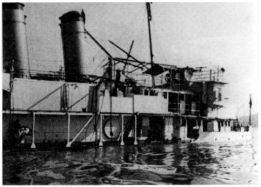The Navy responded quite defensively to the Kiangnan-U.S. Steel exchange, citing its lack of contractual obligations in matters between the two, noting that Kiagnan was "responsible for the contractual performance of its subcontractor," and blaming U.S. Steel for delivery delays; "it does not appear that any functionary of the Navy Department can be considered in any way responsible for delays" - although the Navy already had chastised the officer responsible for timely delivery of this steel.
Construction of the gunboats in Shanghai fell behind schedule immediately, not because of any design, shipping, and quality problems, but also because of many design, shipping, and quality control problems, but also because of the Chinese Revolution's impact on Kiangnan, as Chiang K'ai-shek's Kuomintang forces swept northward from Canton.
The situation in Shanghai was so disturbed by March 1927 that Commander Border asked Mare Island Navy to halt shipment of gunboat material. Border concluded in his 1 April progress report for hull number 43 that launching and delivery dates were "indefinite" for all six gunboats:
the progress during [March] has been such as will further delay the completion of the vessel, due to stoppage of work on 21 March, due to disturbed conditions in Shanghai... At present, prospects of early full resumption of work are not favorable ... the arrival and taking over of the Works by Shantung forces on the 15th, with the result that all Chinese draftsmen, clerks, and weight clerks quit, and the taking over of the work, by Cantonese [i.e., Kuomintang] forces on the 2lst, resulting in stoppage of practically all work for the remainder of the month.

Commander L.S. Border, Superintending Constructor of the Yangtze Patrol gunboats in Shanghai, described the USS Panay (PG-45) as "strong and well built, and well performed." A fouled launching on 10 November 1927, however, was seen by some as a bad omen; Japanese aircraft sank her "by mistake" in December 1937.
He also had to deal with equipage and personnel issues as construction progressed. Exchanges with the bureaus detailed crew size and changes to the allowance list, which dictated the type and number of almost everything that went on board the new ships, including soap dishes for the crew's heads, toasters in the flag mess, and a brass bed for the admiral's cabin.
The original contract had required gunboat deliverv by Kiangnan to the Navy at monthly intervals beginning with "PG 43" on 1 March 1927; hull number 48 was due on 1 September 1927. Because of the various delays, however, the Asiatic Fleet commander told Washington in early May that Border intended to Launch the first two gunboats (numbers 43 and 44) on 21 and 28 May 1927, respectively. These normally festive events would take place with little ceremony in view of "the present state of conditions in this country."
The gunboats were named officially on 10 May 1927: Guam (PG-43), Tutuilla (PG-44) Panay (PG-45), Oahu (PG-46), Luzon (PG-47), and Mindanao (PG-48) all Pacific Islands. Construction delays resulting from material delays, labor unrest, design changes, and Kiangnan's inexperience resulted in the ships being delivered to the Navy from 10.7 months (Guam) to 15.4 months (Tutuilla) late.
Acceptance trials were more objective and more demanding; the congressionally mandated INSURV Board
was (and still is) notoriously independent and hard to please. Its reports generally were good and recommended all boats for commissioning, with few discrepancies: "panting bulkhead," "suspected structural weakness in stern overhang," "unsatisfactory woodwork finishing."
The ships' launchings were uneventful, except the Panay: on 10 November 1927, the first attempt failed when "after traveling slowly for 30 feet she stopped and was blocked up." The ways were then removed, freshly greased, and replaced. An inferior quality of tallow caused the difficulty. A fouled launching is considered an ill omen and some "old China hands" may not have been surprised when Japanese aircraft sank the ship "by mistake" ten years later.
The fleet commander authorized monthy payments for each gunboat during construction. Kiangnan had performed well enough to receive regular payments, with only small amounts withheld occasionally for unsatisfactory progress; a typical monthly payment to Kiangnan was $21,000 (gold) per ship. Kiangnan's satistactory work was supported further in the INSURV Board's reports and more tangibly by the fleet commander's expeditious authorization of final payment to settle the construction contract. The new ships were well built: when the Guam was fired on by "bandits" in 1929, her bulletproof steel plating prevented crew injuries; periodic INSURV Board